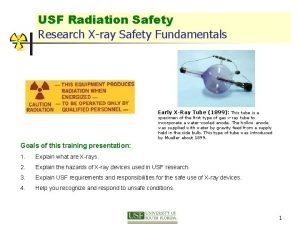Radiation Therapy Introduction to Radiation Oncology n n









- Slides: 9

Radiation Therapy

Introduction to Radiation Oncology n n n Radiation has been an effective tool for treating cancer for more than 100 years. Radiation oncologists are doctors trained to use radiation to eradicate cancer. About two-thirds of all cancer patients will receive radiation therapy as part of their treatment.

What Is Radiation Therapy? n n n Radiation therapy works by damaging the DNA within cancer cells and destroying their ability to reproduce. When the damaged cancer cells are destroyed by radiation, the body naturally eliminates them. Normal cells can be affected by radiation, but they are able to repair themselves. Sometimes radiation therapy is the only treatment a patient needs. Other times, it is combined with other treatments, like surgery and chemotherapy.

Methods of Delivering Radiation Therapy Early 1950 s Today

How Is Radiation Therapy Used? Radiation therapy is used two different ways. n To cure cancer: • Destroy tumors that have not spread to other body parts. • Reduce the risk that cancer will return after surgery or chemotherapy. n To reduce symptoms: • Shrink tumors affecting quality of life, like a lung tumor that is causing shortness of breath. • Alleviate pain by reducing the size of a tumor.

Types of Radiation Therapy n Radiation therapy can be delivered two ways – externally and internally. • External beam radiation therapy delivers radiation using a linear accelerator. • Internal radiation therapy, called brachytherapy or seed implants, involves placing radioactive sources inside the patient. n The type of treatment used will depend on the location, size and type of cancer.

Internal Radiation Therapy n Places radioactive material into tumor or surrounding tissue. • Also called brachytherapy – brachy Greek for “short distance. ” • Radiation sources placed close to the tumor so large doses can hit the cancer cells. • Allows minimal radiation exposure to normal tissue. • Radioactive sources used are thin wires, ribbons, capsules or seeds. • These can be either permanently or temporarily placed in the body.

Side Effects of Radiation Therapy n n Side effects, like skin tenderness, are generally limited to the area receiving radiation. Unlike chemotherapy, radiation usually doesn’t cause hair loss or nausea. Most side effects begin during the second or third week of treatment. Side effects may last for several weeks after the final treatment.

Is Radiation Therapy Safe? n n n Many advances have been made in the field to ensure it remains safe and effective. Multiple healthcare professionals develop and review the treatment plan to ensure that the target area is receiving the dose of radiation needed. The treatment plan and equipment are constantly checked to ensure proper treatment is being given.

















